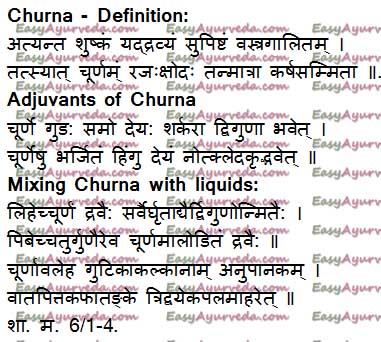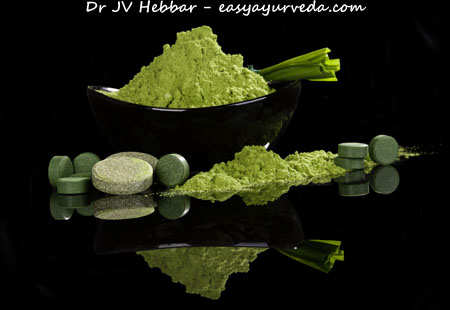Churna Kalpana: Ayurvedic Herbal Powders: Principle, Preparation, Examples
Herbal powders are extensively used in Ayurveda. It is considered as a derived dosage form from herbal paste – Kalka. In Ayurveda, powders are used for oral intake, external application and to prepare other medicines such as herbal ghee and oils.
Table of Contents
Sanskrit verses

द्रव्यमार्द्रं शिलापिष्टं शुष्कं वा सजलं भवेत्। •प्रक्षेपावापकल्कास्ते तन्मानं कर्षसंमितम्॥ (शा.सं.म. ख.५.२)
Sharangdhara Samhita Madhyama Khanda 5/2
The wet or dry herb is triturated as it is or by adding water, it can be added with other adjuvants and administered.
Dose – 1 karsha – 12 grams once or twice per day.
Introduction
Churna – herbal powders:
Churna in general is fine powder of a completely dry herb, which is filtered through a clean cloth.
यः पिण्डो रसपिष्टानां कल्कः स परिकीर्तितः । (च.सू.४)
The Pinda – bolus or paste prepared from fresh herbs, which is rasapishta – has some liquidity in it, is considered as Kalka. Charaka Samhita Sutrasthana 4th chapter
कल्को दृषदि पेषित: ।
उपलदशनदिपिष्टस्तु कल्क: । (अ.सं..सू.४)
Fresh herbs are ground in mortar and pestle to prepare Kalka.
Ashtanga Sangraha, Sutrasthana 4th chapter

Synonyms
Shushka pisti, Shushka Kalka – dry paste = powder
Raja, Kshoda – fine powder.
Churna, Choornam, Churan, Churnam
Instruments used
Khalva Yantra, Ulukhala Yantra – mortar and pestle were the instruments used to prepare churna during olden days.
Now-a-days Pulverizers, Micro-pulverizers, Disintegrates & different mills are used.
Types based on particle size
Types of choornam based on size:
Sthoola Churna : Coarse powder.
Sookshma Churna : Fine powder.
Atyanta Sookshma Churna: Very fine powder.
Types based on ingredients
Types of churnam based on number nad nature of ingredients:
Single herb powders – example – Ginger powder.
Poly herbal powders – example – Trikatu churna – a simple combination of ginger, pepper and long pepper.
Metallic powders – Loha bhasma – iron calx, Yashada bhasma – zinc calx etc.
Dosage, shelf life
Traditional dosage: One Karsha (12 Grams).
Practical dosage: 3 – 6 grams in single or divided doses.
Shelf life is 2 months, as per Sharangdhara Samhita.
If stored in air tight containers, it can be stored up to six months.
Market available churnas have 2 years of shelf life, as per Drugs and Cosmetics Act.
Adjuvants, dosage
Prakshepa Dravyas – adjuvants:
If jaggery is the adjuvant / co prescription, then it should be added to the Churna in equal quantities.
Eg: 3 grams of Trikatu Churna + 3 grams of jaggery, at night after food for 2 weeks time.
If sugar candy is the adjuvant, it is added double the quantity of Churna.
If ghee, honey or sesame oil are to be added, then they have to be added in double the quantity.
Any other liquid – 4 times the quantity of churna.
Dose of Anupana – co drink – based on Dosha:
The quantity of adjuvant along with Churan Gutika & Kalka in
Vata Disorders – 3 times to the medicine.
Pitta Disorders – 2 times to the quantity of medicine
Kapha disorders – equal to the quantity of medicine.
Uses of Churna
Used as a single medicament.
Ex:
Hingwashtaka Churna – used in bloating, Vata disorders etc
Talisadi Churna, Sitopaladi Churna – used in cold, cough, asthma etc.
Used as adjuvant.
Ex: Swarna Bhasma with Trikatu Churna.
Abhraka Bhasma with Talisadi Churna.
For secondary medicine preparations.
Ex: herbal powders are used for the preparation of herbal decoctions, herbal jams (Avaleha), tablets, oils, ghees, fermented preparations called – Asava, Arishta etc.
External use
- For Udvartana – powder massage – Kola Kulatthadi Churna
- For dusting on wounds – neem powder or Triphala powder or a mix of neem and turmeric powder.
- For nasal inhalation – Pradhamana nasya – Eg: Katphala nasya is administered to treat insomnia.
- As tooth powder
- As paste application over skin to relieve pain (Kottamchukkadi churna lepa)
- In sweating treatment – Sweda – Churna Pinda Sweda (Podikizhi) – herbal powders heated and or fried in herbal oils tied in a bolus to rub against the painful parts for a fixed duration of time.
Size reduction of powders
- It is the process of reducing the particle size of a substance to a finer state of subdivision.
- Comminuting & grinding are synonyms. If done by mechanical means it will be called milling.
- Depending on the type of equipment employed for the purpose, this process gets different names.
- Cutting, Chopping, Crushing, Grinding, Milling, Trituration Etc.
Pharmaceutical Application
Lesser the particle size – More the surface area.
Increased surface area of drugs will help in quick extraction of their active principles by facilitating easy penetration of solvent into drug tissue.
Lesser the particle size ? Lesser will be the drying time.
Lesser the particle size ? More the rate of absorption.
The rate of drug absorption depends mainly on the dosage form, route of administration & particle size.
Particle Size
- The particle size of the powders depend on the different numbered standard sieves used.
- Sieving is the process of size separation.
- The numbered sieves indicate the number of meshes (openings) in a length of 1 inch (2.54cm).
- So a sieve numbered 10 will have ten meshes 1 inch length.
Sieve of size separation
- Coarse powders : 10 / 44.
- Moderately coarse powders : 22 / 60.
- Moderately fine powder : 44 / 85.
- All particle should pass through sieve number 10 & not more than 40% should pass through number 44 sieve.
- Fine powder : 85.
- Very fine powder : 120.
- All particles should pass through.
Advantages
- Stability in powders is more when compared with other liquid preparations. (Liquids are more prone for chemical reaction).
- Easily absorbed & metabolized when compared with other solid dosage forms like tablets capsules etc.
- As a result of which the onset of action will be early.
- More economical when compared with any other pharmaceutical preparation.
Disadvantages
- More the exposed drug surface area ? more will be the chances of oxidation & hydrolysis. (So such drugs are to be stored in airtight containers).
- Unpalatable (bitter) drugs cant be dispensed in powder form.
- The drugs may loose their aromatic & volatile principles when subjected for grinding.
- Deliquescent (which melt on exposure) & Hygroscopic drugs (with moisture) cant be dispensed in powder form. Eg: Asafoetida (Heeng), Yavakshara, Apamarga Kshara etc
Factors affecting size reduction
- Physical properties of the drugs such as hardness, toughness, moisture content etc.
- Melting or softening point of the drugs. (Due to the heat generated during mechanical grinding).
- The size of the starting material. If the size is too large then it may need reduction in stages.
- Reduction has to be carried out in aseptic conditions to prevent bacterial contamination (especially in wet conditions).
Methods of Size Reduction
- Slicing & Cutting:– Cutter mill.
Bruising & Contusion – Roller mill - Grinding – Manual – Trituration.
Mechanical. – Levigation, Pulverization. - Mechanical:
Ball mill – https://www.youtube.com/watch?v=O2-gg0C2Asw
Hammer mill.
Edge runner mill.
End runner mill.
The disintegrator.
Bohr stone mill.
Hand mill.
Colloid mill.
Fluid energy mill.
Kashaya Churna
Kashaya Churna / Kwatha Churna
- Usually coarse powder mix.
- Prepared with ingredients of the formula.
- Take the powder, add 16 times water, boil and reduce to 4 parts, filter and use.
- It is better than market available kashaya. Since, it is freshly prepared.
- Eg:
–Dashamoola kashaya churna
–Manjishtadi kashaya churna etc
Pharmacology
- The action of Churna starts from the mouth, as soon as it comes into contact with tongue.
- As per Ayurveda, not only the medicinal active principles, even the taste of the medicine has its own effect on the patient.
- Sweet – calming,
- Salt, sour, pungent – stimulating, initiating
- Astringent – stopping, blocking effect (Stambhana etc)
- In case of cough, cold, nose blockage, most of the churnas are spicy (Talisadi, Trikatu – Ginger, black pepper, long pepper, Sitopaladi etc).
- As soon as they come into contact with tongue, due to higher temperature in oral cavity, volatile principles are released into mouth and oral cavity, helping the patient with breathing.
- If the product is administered along with ghee, ghee protects the mucosal lining from spices. Hence, in Pitta persons, ghee is very useful. Eg: Hingwashtaka Churna – is administered along with ghee.
- If the product is administered with honey, it gets absorbed and spreads to the target organ quickly, due to catalystic activity (Yogavahi) property of honey.
- If the product is made with sugar, jaggery, then it will take longer time to dissolve and its action can be expected more at stomach and intestines, rather in oral cavity.
Ayurvedic Churna formulations
Some interesting Churna
- Sarshapadi Churna
- For external application only.
This is mixed with Eladi taila or Nalpamaradi taila or other media and applied over the affected area. - It is used in the treatment of filariasis.
It is also used in itches, scabies and visarpa. - Arya Vaidya Sala
- It is used in the treatment of Rheumatoid arthritis, pain and inflammation of joints, osteo arthritis, back pain, sciatica and such other joint diseases.
- Is advised to administer with hot water as Anupana.
- It can also be made into tablet with jaggery as base.
- It helps relieve sprue, cough, cold, useful in Asthma, chronic respiratory conditions, anorexia, running nose.
- Contains Cannabis and sugar as ingredient
Pushyanuga Churna
Menorrhagia, Metrorrhagia, Leucorrhoea, Menstrual disorder, Excessive menstrual bleeding of various aetiology. It is also used in treating uterine infections and Haemorrhoids. This is good in diarrhoea, dysentry, grahani and raktapitta.
Herbs are to be collected in Pushya month – December – January
Mix with honey, make a paste, consume it along with rice washed water (Tandulodaka)
Narasimha Churna
It is used in the Ayurvedic treatment of cough, chronic respiratory conditions like bronchitis and asthma, Oligospermia, anti aging treatment, chronic urinary diseases, Anemia, gout, Fistula, Sciatica, chronic jaundice, hemorrhoids.
Special method of preparation
The fine powder of all the herbs along with honey, ghee and sugar is kept in a tightly closed container for a while.
The fine powder of all the herbs along with honey, ghee and sugar is kept in a tightly closed container for a while.
- It helps to relieve burning sensation, headache, dizziness, eye diseases, cough with sputum.
- Very beneficial in confusion of mind, giddiness, insomnia
- For external application only.
Traditionally it is made a paste with breast milk or suitable medicated oils or ghees and applied over forehead or crown.








3 comments
Amrita
Why is churna anjana milder than Gutika anjana if churna ahas minute particles than Gutika ?
Dr J V Hebbar MD(Ayu)Author
I have to check its truth. But a gutika anjana with honey or any liquid would stick very well to the eyes and might stay on the eyes for longer period of time, where churna anjana could cause irritation and might stay for a shorter period of time, this could be the reason.
Laxmi
Thank you dr hebbar